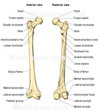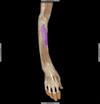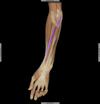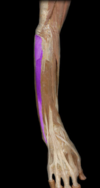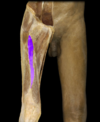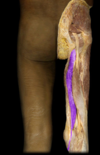Practical 3 Flashcards
(326 cards)
Identify the acromial end

End attached to the top of the shoulder (lateral end, top curved side that is not smooth)

Identify the sternal end of the clavical

End attahed to the sternum area (more radial curve - skinnier bone diameter) - smooth

Identify the acromion process of the scapula

Projection of the spine that arches over the glanohumeral joint and articulates with the clavicle (top hook)

Identify the coracoid process

The hook-like projection, which lies just underneath the clavicle (lower hook)

Identify the glenoid cavity

Shallow pyriform, articular surface, which is located on the lateral angle of the scapula (articulates with humerus)

Identify the supraspinous fossa

The area above the spine of the scapula, it is much smaller than the infraspinous fossa, and is more complex in shape (above the spine, large flat lower surface)

Identify the infraspinous fossa

THe area below the spine of the scapula, it displays a convex shape. the infraspinatus muslce originates from here (Below spine large flat surface)

Identify the subscapular fossa

A concave depression over most of the scapula surface (inside scapula)

Idenify the medial boarder

AKA the vertebral border of the scapula, the “internal boarder of the scapula” and sometimes as the “base of the scapula (Medial edge)

Identify the scapular spine

A prominent plate of bone, which crosses obliquely the medial four-fiths of the scapula at its upper part (large ridge)

Identify the head of the humerus

Projects medially and superiorly to articulate with the glendoid cavity of scapula. Connected to the tubercles by the anatomical neck (Top round - large)
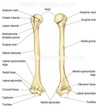
Identify the greater tubercle

Located laterally on the humerus. Has an anterior and posterior face. It serves as attachment site for three of the rotator cuff muscles (Top small nub)

Identify the lesser tubercle

Smaller and more medially located on the bone. Only has an anterior face. Attachment surface for last rotator cuff muscle (lower baby nub on top head of humerus)

Identify the intertubercular sulcus

Separating the two tubercles is a deep depression or groove houses many tendons through grove (between greater and lesser)

Identify the deltoid terberosity

On the lateral side of the humeral shaft is a roughened surface where the deltoid muslce attaches (midshaft rough part - ridge)

Idendify the glenohumeral ligaments

Located between scapula (edge of glenoid fossa) and humerous

Identify the coracohumeral ligament

Between scapula (root of coracoid process) and humerus - greater tubercle

Identify the transverse humeral ligament

Broad band passing from the lesser tubercle to the greater tubercle of humerus (around the outside - not on the model in class)

Identify the acromioclavicular ligament

Is a quadrilateral band, covering the superior part of the articulaty and extesnion between the upper part of the lateral end of clavicle

Identify the coracoclavicular ligament

Between coracoid process and clavicle (clavical attached to scapula - lower)

Identify the coracoacromial ligament

On the scapula between strong liganent coracoid process and acromion (holds onto the two spines)

Identify the glenoid labrum

Attaches around the margin of the glenoid cavity (around glenoid fossa - large ligament connects to humerus)

what is #1

Acromion process (top hook)

What is the no numbered mark on one side and #15 on right side?

Coracoid process (lower hook)






















































































































































































